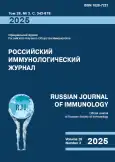Длительная активация тучных клеток как экспериментальная модель для исследования их роли в регуляции сперматогенеза
- Авторы: Садек А.1,2, Печенкина М.А.1, Храмцова Ю.С.3
-
Учреждения:
- Уральский федеральный университет имени первого Президента России Б.Н. Ельцина
- Институт медицинских клеточных технологий
- Институт иммунологии и физиологии Уральского отделения Российской академии наук
- Выпуск: Том 28, № 3 (2025)
- Страницы: 487-494
- Раздел: КРАТКИЕ СООБЩЕНИЯ
- URL: https://journal-vniispk.ru/1028-7221/article/view/319890
- DOI: https://doi.org/10.46235/1028-7221-17180-LTA
- ID: 319890
Цитировать
Полный текст
Аннотация
Тучные клетки являются важным компонентом иммунного микроокружения органов мужской репродуктивной системы и участвуют в их регуляции в норме и при патологии. Моделирование дисрегуляции в виде активации или ингибирования тучных клеток и исследование влияния данного нарушения на сперматогенез может помочь в установлении точных механизмов регуляции данного процесса. Одним из активаторов тучных клеток является препарат Ципрофлоксацин, который зарекомендовал себя в исследованиях тучных клеток сердца, однако ранее не использовался в работах по изучению сперматогенеза. Цель данного исследования – оценить влияния разных схем приема препарата Ципрофлоксацин на тучные клетки репродуктивных органов самцов крыс и выбрать оптимальную дозу и продолжительность приема для создания модели, которая позволит исследовать участие тучных клеток в регуляции сперматогенеза. Эксперимент проведен на самцах линии Wistar. Использовали разные концентрации ципрофлоксацина (200 и 400 мг/кг) и сроки его приема. На гистологических препаратах оценивали морфофункциональные параметры тучных клеток семенников и придатков семенников. Препарат Ципрофлоксацин модулирует активность тучных клеток в зависимости от времени, дозы и ткани. После приема препарата в дозе 200 мг/кг 7 суток увеличивается количество, синтетическая активность тучных клеток и процент клеток со зрелыми гранулами как в семенниках, так и в придатках наряду с неизменной дегрануляцией, что указывают на прохождение «подготовительной» фазы, заключающейся в миграции тучных клеток в репродуктивные органы и накоплении ими секрета. После следует начало активной дегрануляции, которая сопровождается возвращением количества тучных клеток к показателю интактной группы, сохранением повышенной синтетической активности и преобладанием в семенниках клеток со зрелыми гранулами. Более высокая доза ципрофлоксацина (400 мг/кг) ускоряет активацию тучных клеток, что приводит к более ранней дегрануляции. Количество и функциональные параметры тучных клеток под действием препарата изменяются аналогично в обоих исследуемых органах, однако наблюдаемые морфометрические изменения и показатели созревания гранул демонстрируют тканеспецифические адаптивные реакции. Проведенное исследование дает основание рекомендовать дозу 400 мг/кг в течение 7 дней для активации тучных клеток в репродуктивных органах самцов крыс и изучения сперматогенеза. Дозу 200 мг/кг следует использовать с целью предварительной стимуляции миграции тучных клеток, повышения их синтетической активности и созревания перед применением другого активатора – индуктора дегрануляции. Данная доза также будет предпочтительной для более длительных экспериментов, чтобы свести к минимуму потенциальные побочные эффекты, связанные с более высокой дозировкой.
Ключевые слова
Полный текст
Открыть статью на сайте журналаОб авторах
А. Садек
Уральский федеральный университет имени первого Президента России Б.Н. Ельцина; Институт медицинских клеточных технологий
Email: sadek1996@mail.ru
аспирант, инженер-исследователь департамента биологии и фундаментальной медицины; научный сотрудник центральной экспериментальной лаборатории биотехнологий
Россия, Екатеринбург; ЕкатеринбургМ. А. Печенкина
Уральский федеральный университет имени первого Президента России Б.Н. Ельцина
Email: sadek1996@mail.ru
студент департамента биологии и фундаментальной медицины
Россия, ЕкатеринбургЮ. С. Храмцова
Институт иммунологии и физиологии Уральского отделения Российской академии наук
Автор, ответственный за переписку.
Email: sadek1996@mail.ru
к.б.н., доцент, старший научный сотрудник лаборатории иммунофизиологии и иммунофармакологии
Россия, ЕкатеринбургСписок литературы
- Bankhead P., Loughrey M.B., Fernández J.A., Dombrowski Y., McArt D.G., Dunne P.D., McQuaid S., Gray R.T., Murray L.J., Coleman H.G. QuPath: Open source software for digital pathology image analysis. Sci. Rep., 2017, Vol. 7, no. 1, 16878. doi: 10.1038/s41598-017-17204-5
- Baran J., Sobiepanek A., Mazurkiewicz-Pisarek A., Rogalska M., Gryciuk A., Kuryk L., Abraham S.N., Staniszewska M. Mast cells as a target – A comprehensive review of recent therapeutic approaches. Cells, 2023, Vol. 12, no. 8, 1187. doi: 10.3390/cells12081187.
- Himelreich-Perić M., Katušić-Bojanac A., Hohšteter M., Sinčić N., Mužić-Radović V., Ježek D. Mast cells in the mammalian testis and epididymis – Animal models and detection methods. Int. J. Mol. Sci., 2022, Vol. 23, no. 5, 2547. doi: 10.3390/ijms23052547.
- Kuzmin V., Voronina Y., Abramov A., Karkhov A., Fedorov A. Prolonged stimulation of resident mast cells suppresses the automaticity of the sinus node of the heart via histamine H1 receptors. Receptors and Intracellular Signaling, 2023, pp. 404-408. (In Russ.)
- Liu R., Hu S., Zhang Y., Che D., Cao J., Wang J., Zhao T., Jia Q., Wang N., Zhang T. Mast cell-mediated hypersensitivity to fluoroquinolone is MRGPRX2 dependent. Int. Immunopharmacol., 2019, Vol. 70, pp. 417-427.
- McNeil B.D. MRGPRX2 and adverse drug reactions. Front. Immunol., 2021, Vol. 12, 676354. doi: 10.3389/fimmu.2021.676354.
- McNeil B.D., Pundir P., Meeker S., Han L., Undem B.J., Kulka M., Dong X. Identification of a mast-cell-specific receptor crucial for pseudo-allergic drug reactions. Nature, 2015, Vol. 519, no. 7542, pp. 237-241.
- Sadek A., Khramtsova Y., Yushkov B. Mast cells as a component of spermatogonial stem cells’ microenvironment. Int. J. Mol. Sci., 2024, Vol. 25, no. 23, 13177. doi: 10.3390/ijms252313177.
- Schindelin J., Arganda-Carreras I., Frise E., Kaynig V., Longair M., Pietzsch T., Preibisch S., Rueden C., Saalfeld S., Schmid B. Fiji: an open-source platform for biological-image analysis. Nat. Methods, 2012, Vol. 9, no. 7, pp. 676-682.
Дополнительные файлы








